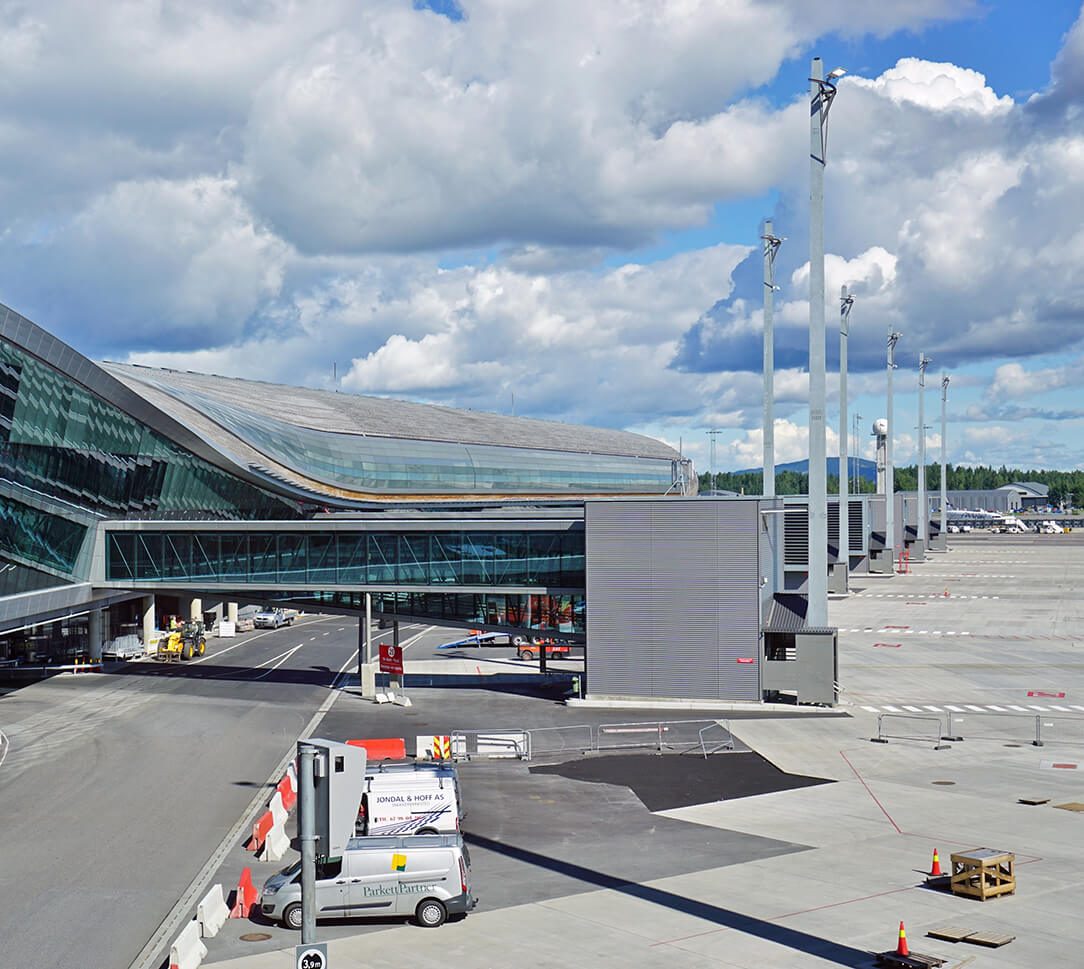The OAC area
Oslo Airport City represents today's most important destination development, in the form of a multicore, transit-oriented hub. Innovative, economically sustainable, and urban qualities become regional "growth drivers" in this long-term commitment to infrastructure.

Transit-oriented development
Ullensaker Municipality, with its approximately 43,000 inhabitants, is one of the fastestgrowing municipalities in Norway, both in terms of jobs and population. The projections, prepared by Statistics Norway, predict a significant future growth over the next 15 years.
Ullensaker Municipality is the home of Oslo Airport Gardermoen/OSL and positions itself as a business- friendly, flexible, and solution-oriented municipality that aims to facilitate longterm and sustainable development and growth with new, permanent jobs.
The area with Oslo Airport City, OSL, and Jessheim is experiencing increasing interest and strong development in both business establishments and residential construction. The airport, commerce, hotels/conference centres, transportation, and communication have replaced defence and agriculture as the main occupations in the region. The establishment of a clear urban city structure with a strong focus on additional housing growth and associated services and infrastructure such as commerce, catering, recreation, kindergartens/schools etc. supports Oslo Airport City's vision and goal of being Norway's fastest growing and most attractive destination.
Approx. 43.000 inhabitants in Ullensaker Municipality
2,5 % average population growth per year


Gardermoen (including Jessheim, Gardermoen Business Park and the airport) has already been designated by Ullensaker Municipality as a special area for increased urban and economic development. Ullensaker Municipality currently has 43,000 inhabitants, with 20,000 located in Jessheim.


A sustainable region
Political anchoring and determination form an invaluable basis for the further development of Oslo Airport City as an important part of Norway's national transit-oriented development, Gardermoen.
The Regional Plan for Land Use and Transport for Oslo and Akershus was adopted in
December 2015 by Oslo Municipality and Akershus County Municipality. This plan continued in the new Viken County from 1 January 2020 and will be an important and crucial part of the new Akershus after the election in September 2023.
The plan is a direct follow-up to the Norwegian Parliament's decision (Ot.prp.nr. 10, 2008/09) whereby Oslo and Akershus are required to create a plan for a change in direction in the Capital Region to achieve the goals of a more competitive and sustainable region, as well as national goals for climate and transportation.
The Norwegian State is thus obliged to follow up on the plan, along with Oslo Municipality, Viken County Municipality, and all municipalities in Viken (which will become the new Akershus after the election in 2023). The plan extends to 2030, with a perspective towards 2050.
Gardermoen Region Intermunicipal Political Council (GRIP)
From 1 January 2019, the cooperation between the six municipalities around Gardermoen
has formally been established as an inter-municipal political council. The council is a continuation of the long-standing cooperation "Øvre Romerike Utvikling" The participating municipalities remain the same: Eidsvoll, Gjerdrum, Hurdal, Nannestad, Nes, and Ullensaker.
The Strategic Business Plan for the Gardermoen Region was adopted on 23 April 2021. The strategic plan has a vision of: "Gardermoen Region, the gateway to the world, with a focus on technology, expertise, local value creation, and sustainability."
Through its CEO, OAC actively participates as a member of the steering group for GRIP, with a focus on destination and business development for the entire region. Read more about the Strategic Business Plan here.

Regional cities in rapid growth
In the Oslo region, emphasis is placed on highly concentrated urban development based on the principles of multicore development of vibrant cities with a good quality of life and public transportation solutions located around Oslo city. The regional cities will play a more significant role in the growth of housing and workplaces, accounting for a substantial proportion (80-90%) of the overall development.
Jessheim is highlighted as a regional town with high growth, where urban development and economic activities will be facilitated in line with increased airport activity. Øvre Romerike is already a major commuter region for the entire Gardermoen area. It is desirable to continue this development in such a way that increased commuting will be based on public transportation. The plan will strengthen the public transportation network between Jessheim and Oslo Airport Gardermoen through Gardermoen Business Park, with workplace-intensive activities located near the transit-oriented development.In February 2020, Ullensaker Municipality adopted a new strategic plan confirming the transit- oriented development of Gardermoen and Jessheim, integrating international standards.
20 min. from Oslo Central Station to OAC
5 min. Airport Shuttle from OSL to OAC
40 % of Norways' pupulation can reach OAC in two hours by train, bus or car
300 mill. Europeans can be reached within 2 hours

Oslo Airport is Norway's and perhaps the Nordic region's most important transitoriented development.
Oslo Airport City is ideally located, with proximity to the airport, main road routes, a future cargo terminal and attractive residential areas in Jessheim, with short travel time to Oslo city centre, its suburban districts and central Europe.
From Oslo Airport City, some of Norway's largest and most important regional cities - Bergen, Trondheim, Tromsø, Stavanger, and Kristiansand - are just a short journey away. These areas have important industries that are focusing on developing their own growth areas. OAC has the potential to become the Norway's public face and strengthen the country's competitiveness. A two-hour train, bus, or car journey can connect you with two million individuals (40% of Norway's population). Furthermore, a two-hour flight can connect you with around 300 million Europeans.
Global city
The development of high-speed rail lines is changing the dynamics in Scandinavia and connecting us more closely with our neighbours. OAC/Oslo plays an important role as an anchor point in this development. With a potential new cargo terminal at Hauerseter, the railway network strengthens OAC as a destination, contributing to enhancing Scandinavia's global competitiveness.
450km from Oslo to Bergen
560 km from Oslo to Stavanger
420 km from Oslo to Stockholm
940 from Oslo to Copenhagen

Scandinavia's largest airport
Oslo Airport Gardermoen (OSL) is Norway's main airport and the country's most central and important transit-oriented development. Besides air traffic, OSL has airport hotels, conference facilities, businesses, eateries, and other service functions, as well as over 20,000 parking spaces. Up until 2020, OSL had approximately 30 million travellers and continues to be the region's second-largest airport. Between 2005 and 2020, there was a significant employment growth in hotels, restaurants, and retail - increasing from 11% to about 21%. This growth is connected to the airport, which today employs approximately 15,000 people - around 25,000 if you include subcontractors.
In 2022 OSLo had approx. 22,5 million travellers and was thus Scandinavia's largest airport. In 2022 Kastrup had approx 22,1 million travelers.
This number may double by 2050, and investments in OSL as the main airport have positioned OSL as one of the country's largest workplaces. OSL/Avinor
OSL / Avinor ( https://avinor.no/flyplass/oslo )